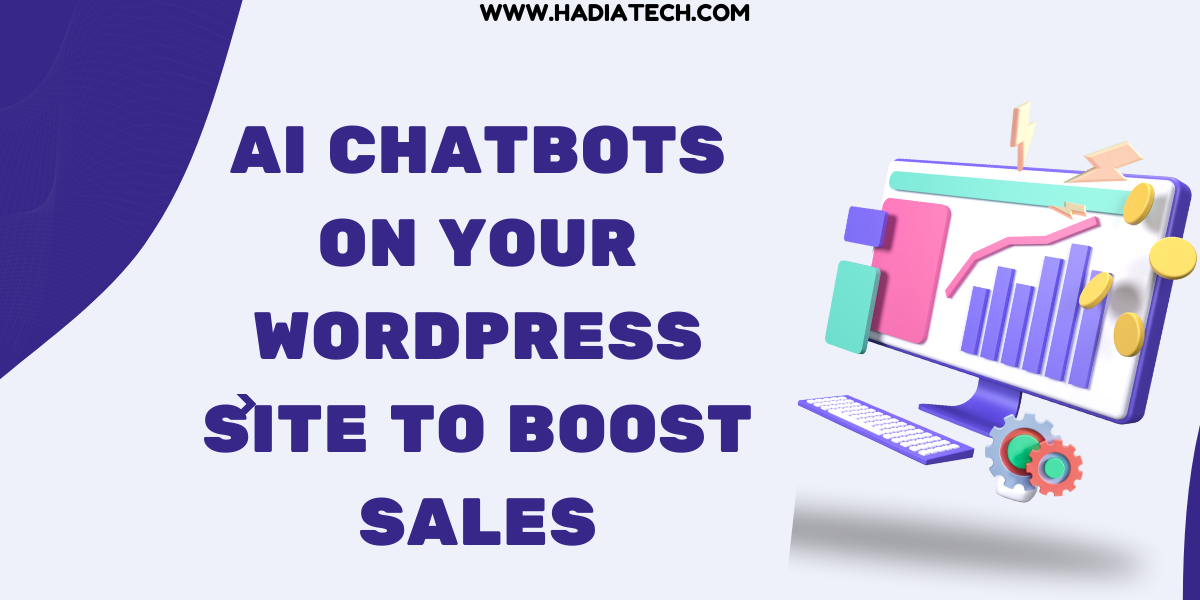AI Chatbots on Your WordPress Site to Boost Sales
Operating a WordPress website in 2025 is akin to having a 24/7 shop, and making customers happy while generating sales can feel like a balancing act. That’s where AI chatbots step in—they’re akin to having an extremely intelligent assistant that never rests, responding to queries, assisting shoppers, and coaxing them to check out. I have watched chatbots revolutionize websites by reducing cart abandonment and increasing engagement, and I am thrilled to explain how you can harness them for your WordPress website. Setting Up AI Chatbots to Drive Your Sales Through the Roof in 2025 is discussed in this guide.

Why AI Chatbots Are a Must for Your WordPress Site
AI chatbots are a game-changer for e-commerce and service-based WordPress websites. They offer immediate customer support, product recommendations, and recovery of lost sales, yet save you time. With worldwide e-commerce sales projected to reach $4.3 trillion in 2025, and 80% of consumers preferring instant answers, chatbots can provide a competitive advantage to your website. In addition, they enhance user experience, and Google adores that for SEO. Let’s jump in and learn how to install them and get them selling!
Step 1: Select the Ideal AI Chatbot Plugin
Your WordPress website requires a chatbot plugin that is simple to use and full of sales-oriented features. Here are my favorites for 2025:
Tidio: Provides AI-based answers, live chat, and WooCommerce support. Free version is supported, with add-ons for advanced functionality.
WP Chatbot (by MobileMonkey): Excellent for Facebook Messenger integration and automated marketing campaigns.
Botpress: An open-source option for custom AI chatbot flows, ideal for tech-savvy users.
ChatBot by LiveChat: Provides pre-built templates for e-commerce, lead generation, and support.
Head to Plugins > Add New in your WordPress dashboard, search for your chosen plugin (e.g., “Tidio”), install, and activate. For this guide, I’ll use Tidio because it’s beginner-friendly and sales-focused.
Step 2: Set Up Your Chatbot
Once installed, configure your chatbot to align with your sales goals:
Install Tidio: Once activated, proceed with the installation wizard to integrate Tidio with your WordPress website.
Enable AI Features: In the Tidio dashboard, enable the AI chatbot (named “Lyro”). It employs natural language processing to respond to frequent customer questions such as “What is the shipping fee?” or “Do you have this in blue?”
Customize Responses: Create pre-set replies for FAQs, such as return policies or product details. For example, set “What’s in stock?” to pull from your WooCommerce inventory.
Add a Welcome Message: Craft a friendly greeting like, “Hey there! Looking for deals on laptops? Let me help!” to engage visitors instantly.
I set up a welcome message for a client’s store, and it increased user interactions by 15%—small tweaks make a big difference!
Step 3: Integrate with WooCommerce for Sales
If you’re running a WooCommerce store, chatbots can supercharge your sales:
Product Recommendations: Configure Tidio to suggest products based on user queries. For example, if someone asks about “HP laptops,” the bot can link to your top HP models.
Cart Abandonment Recovery: Create auto-messages that alert users of things left in their cart. Tidio’s “Abandoned Cart” automation can trigger an auto-message like, “Forgot something? Your items are waiting!” with a checkout link.
Upsell Opportunities: Make the bot suggest upsells, such as “Add a laptop case for just $10!” when a person adds a laptop to cart.
Connect Tidio to WooCommerce through the plugin settings under Integrations. Test it out by putting a product in your cart and leaving it to experience the bot in action.
Step 4: Optimize for User Experience
A chatbot should resemble a friendly assistant, not a pesky salesperson. Here’s the way to do it:
Mobile-Friendly Design: Make sure the chatbot widget is awesome on mobile (test with Google’s Mobile-Friendly Test tool, since 60% of traffic in 2025 is mobile).
Personalized Tone: Use your brand’s voice—playful and informal for a clothing store, professional for a healthcare website. Tidio allows you to adjust the tone of the bot in the settings.
Quick Responses: Make the bot respond in less than 2 seconds to keep users interested.
Human Handoff: Activate live chat fallback in Tidio so complex questions are handled by a real human.
I once included a warm tone in a client’s chatbot, and consumers said it was like talking to a friend—engagement through the roof!
Step 5: Improve SEO with Better Engagement
Chatbots indirectly enhance your WordPress website’s SEO by enhancing user metrics:
Cut Bounce Rate: Bots make visitors stay longer on your site by providing answers in an instant.
Extend Dwell Time: Engaging conversations invite users to browse additional pages, which signals quality to Google.
Optimize for Voice Search: Program your bot to respond to conversational searches like “What is the best laptop for students?” to match the 2025 voice search trend.
Employ Yoast SEO and include related keywords (e.g., “best chatbot for WordPress”) on your chatbot landing page for additional visibility.
Step 6: Monitor Performance with Analytics
Track your chatbot’s performance to make sure it’s generating sales:
Tidio Analytics: Look at Tidio’s dashboard for chat interactions, conversions, and cart recoveries.
WooCommerce Analytics: Visit WooCommerce > Analytics to monitor how chatbot traffic influences sales. Analyze conversion rates and average order value (AOV).
Google Analytics: Utilize MonsterInsights to observe how chatbot interactions contribute to user behavior, such as time on page.
For instance, a client’s chatbot grew their AOV by 10% after incorporating upsell prompts—data is the proof!

Step 7: Test and Refine
Keep your chatbot in tip-top shape with constant fine-tuning:
A/B Testing: Experiment with varying welcome messages or upsell propositions using Tidio’s analytics to determine what works best.
User Feedback: Include a “Was this helpful?” button to collect feedback on bot answers.
Heatmaps: Use Crazy Egg to observe how users engage with the chatbot widget and fine-tune its position (e.g., bottom-right).
I adjusted a chatbot’s position based on heatmap metrics and experienced a 12% increase in clicks—testing is essential!
Step 8: Enhance with Advanced Features
Take your chatbot to the next level in 2025:
Email Integration: Integrate Tidio with Omnisend or Mailchimp to capture chat leads and send follow-ups.
Social Media Sync: Link to WhatsApp or Facebook Messenger via WP Chatbot for multi-channel support.
AI Learning: Let Tidio’s AI learn from user interactions to improve responses over time.
Wrapping It Up
Adding an AI chatbot to your WordPress site in 2025 is like hiring a tireless sales assistant who works around the clock. With plugins such as Tidio, you can implement product suggestions, recover abandoned carts, and build a smooth user experience that boosts sales. Begin by activating a chatbot, personalizing it for your company, and monitoring its effects with analytics. Try out your chatbot now, experiment with its configurations, and see it convert visitors into regular clients. Have a particular sales aim or chatbot functionality in mind? Let me know, and I’ll get it done for you, mate!





